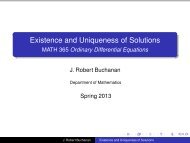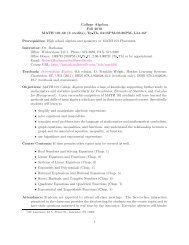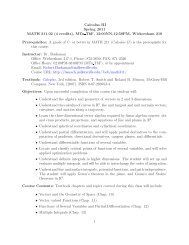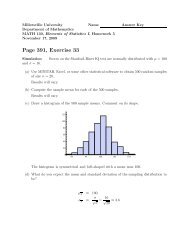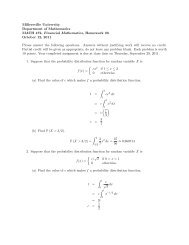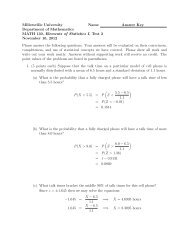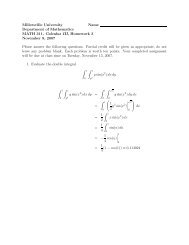Newton's Method - MATH 375 Numerical Analysis
Newton's Method - MATH 375 Numerical Analysis
Newton's Method - MATH 375 Numerical Analysis
Create successful ePaper yourself
Turn your PDF publications into a flip-book with our unique Google optimized e-Paper software.
Newton’s <strong>Method</strong><br />
<strong>MATH</strong> <strong>375</strong> <strong>Numerical</strong> <strong>Analysis</strong><br />
J. Robert Buchanan<br />
Department of Mathematics<br />
Fall 2010<br />
J. Robert Buchanan Newton’s <strong>Method</strong>
Motivation<br />
Newton’s <strong>Method</strong> offers superior performance in root finding<br />
over the Bisection <strong>Method</strong> and ad hoc fixed-point methods.<br />
We will take the approach of deriving Newton’s <strong>Method</strong> using<br />
Taylor’s Theorem.<br />
J. Robert Buchanan Newton’s <strong>Method</strong>
Derivation<br />
Assumptions:<br />
Suppose f ∈ C 2 [a, b] with f(p) = 0 for some p ∈ (a, b).<br />
Let p0 ∈ [a, b] with f ′ (p0) = 0.<br />
Find the Taylor polynomial of degree 2 centered at p0.<br />
J. Robert Buchanan Newton’s <strong>Method</strong>
Derivation<br />
Assumptions:<br />
Suppose f ∈ C 2 [a, b] with f(p) = 0 for some p ∈ (a, b).<br />
Let p0 ∈ [a, b] with f ′ (p0) = 0.<br />
Find the Taylor polynomial of degree 2 centered at p0.<br />
f(x) = f(p0) + f ′ (p0)(x − p0) + f ′′ (z(x))<br />
(z(x) between x and p0)<br />
J. Robert Buchanan Newton’s <strong>Method</strong><br />
2<br />
(x − p0) 2
Derivation<br />
Assumptions:<br />
Suppose f ∈ C 2 [a, b] with f(p) = 0 for some p ∈ (a, b).<br />
Let p0 ∈ [a, b] with f ′ (p0) = 0.<br />
Find the Taylor polynomial of degree 2 centered at p0.<br />
f(x) = f(p0) + f ′ (p0)(x − p0) + f ′′ (z(x))<br />
(z(x) between x and p0)<br />
f(p) = f(p0) + f ′ (p0)(p − p0) + f ′′ (z(p))<br />
(z(p) between p and p0)<br />
J. Robert Buchanan Newton’s <strong>Method</strong><br />
2<br />
2<br />
(x − p0) 2<br />
(p − p0) 2
Derivation<br />
Assumptions:<br />
Suppose f ∈ C 2 [a, b] with f(p) = 0 for some p ∈ (a, b).<br />
Let p0 ∈ [a, b] with f ′ (p0) = 0.<br />
Find the Taylor polynomial of degree 2 centered at p0.<br />
f(x) = f(p0) + f ′ (p0)(x − p0) + f ′′ (z(x))<br />
(z(x) between x and p0)<br />
f(p) = f(p0) + f ′ (p0)(p − p0) + f ′′ (z(p))<br />
(z(p) between p and p0)<br />
0 = f(p0) + f ′ (p0)(p − p0)<br />
<br />
small<br />
0 ≈ f(p0) + f ′ (p0)(p − p0)<br />
p ≈ p0 − f(p0)<br />
f ′ (p0)<br />
2<br />
2<br />
+ f ′′ (z(p))<br />
2<br />
J. Robert Buchanan Newton’s <strong>Method</strong><br />
(x − p0) 2<br />
(p − p0) 2<br />
(p − p0) 2<br />
<br />
very small
Iterative <strong>Method</strong><br />
Thus if p0 is an approximation to the root p of function f , then<br />
is a “better” approximation to p.<br />
p1 ≡ p0 − f(p0)<br />
f ′ (p0)<br />
J. Robert Buchanan Newton’s <strong>Method</strong>
Iterative <strong>Method</strong><br />
Thus if p0 is an approximation to the root p of function f , then<br />
is a “better” approximation to p.<br />
p1 ≡ p0 − f(p0)<br />
f ′ (p0)<br />
Define the sequence {pn} ∞ n=0 by<br />
pn = pn−1 − f(pn−1)<br />
f ′ , for n ≥ 1.<br />
(pn−1)<br />
J. Robert Buchanan Newton’s <strong>Method</strong>
Graphical Interpretation<br />
y<br />
p0 p p2 p1 p 0,fp 0<br />
J. Robert Buchanan Newton’s <strong>Method</strong><br />
y fx<br />
p 1,fp 1<br />
Slope f’p 1<br />
Slope f’p 0<br />
x
Algorithm<br />
INPUT initial approximation p0, tolerance ǫ, maximum<br />
iterations N.<br />
STEP 1 Set i = 1.<br />
STEP 2 While i ≤ N do STEPS 3–6.<br />
STEP 3 Set p = p0 − f(p0)<br />
f ′ (p0) .<br />
STEP 4 If |p − p0| < ǫ then OUTPUT p, STOP.<br />
STEP 5 Set i = i + 1.<br />
STEP 6 Set p0 = p.<br />
STEP 7 OUTPUT “The method failed after N iterations.”,<br />
STOP.<br />
J. Robert Buchanan Newton’s <strong>Method</strong>
Algorithm<br />
INPUT initial approximation p0, tolerance ǫ, maximum<br />
iterations N.<br />
STEP 1 Set i = 1.<br />
STEP 2 While i ≤ N do STEPS 3–6.<br />
STEP 3 Set p = p0 − f(p0)<br />
f ′ (p0) .<br />
STEP 4 If |p − p0| < ǫ then OUTPUT p, STOP.<br />
STEP 5 Set i = i + 1.<br />
STEP 6 Set p0 = p.<br />
STEP 7 OUTPUT “The method failed after N iterations.”,<br />
STOP.<br />
Remark: alternative stopping criteria may be used.<br />
J. Robert Buchanan Newton’s <strong>Method</strong>
Example<br />
Find a root of x − 4 ln x = 0 on interval [1/2, 3/2] using p0 = 1<br />
and ǫ = 10 −5 .<br />
J. Robert Buchanan Newton’s <strong>Method</strong>
Example<br />
Find a root of x − 4 ln x = 0 on interval [1/2, 3/2] using p0 = 1<br />
and ǫ = 10 −5 .<br />
If f(x) = x − 4 ln x then f ′ (x) = 1 − 4/x = 0 on [1/2, 3/2].<br />
pn = pn−1 − pn−1 − 4 ln pn−1<br />
1 − 4<br />
p n−1<br />
n pn<br />
0 1.00000<br />
1 1.33333<br />
2 1.42464<br />
3 1.42960<br />
4 1.42961<br />
J. Robert Buchanan Newton’s <strong>Method</strong>
Convergence<br />
Remarks:<br />
Newton’s <strong>Method</strong> requires the initial approximation p0 be<br />
“reasonably close” to p.<br />
If f ′ (pn) = 0 for any n, the method fails.<br />
J. Robert Buchanan Newton’s <strong>Method</strong>
Convergence<br />
Remarks:<br />
Newton’s <strong>Method</strong> requires the initial approximation p0 be<br />
“reasonably close” to p.<br />
If f ′ (pn) = 0 for any n, the method fails.<br />
Theorem<br />
If f ∈ C2 [a, b] and if p ∈ (a, b) is such that f(p) = 0 and<br />
f ′ (p) = 0, then there exists δ > 0 such that Newton’s <strong>Method</strong><br />
generates a sequence {pn} ∞ n=0 converging to p for any initial<br />
approximation p0 ∈ [p − δ, p + δ].<br />
J. Robert Buchanan Newton’s <strong>Method</strong>
Proof (1 of 3)<br />
Let g(x) = x − f(x)<br />
f ′ (x) , then pn = g(pn−1).<br />
Choose k ∈ (0, 1).<br />
J. Robert Buchanan Newton’s <strong>Method</strong>
Proof (1 of 3)<br />
Let g(x) = x − f(x)<br />
f ′ (x) , then pn = g(pn−1).<br />
Choose k ∈ (0, 1).<br />
Since f ′ is continuous and f ′ (p) = 0, then there exists<br />
δ1 > 0 such that f ′ (x) = 0 for all<br />
x ∈ [p − δ1, p + δ1] ⊆ [a, b]. Consequently g(x) is defined<br />
and continuous for all x ∈ [p − δ1, p + δ1].<br />
J. Robert Buchanan Newton’s <strong>Method</strong>
Proof (2 of 3)<br />
g(x) = x − f(x)<br />
f ′ (x)<br />
g ′ (x) = 1 − f ′ (x) f ′ (x) − f(x) f ′′ (x)<br />
[f ′ (x)] 2<br />
= f(x) f ′′ (x)<br />
[f ′ (x)] 2<br />
J. Robert Buchanan Newton’s <strong>Method</strong>
Proof (2 of 3)<br />
g(x) = x − f(x)<br />
f ′ (x)<br />
g ′ (x) = 1 − f ′ (x) f ′ (x) − f(x) f ′′ (x)<br />
[f ′ (x)] 2<br />
= f(x) f ′′ (x)<br />
[f ′ (x)] 2<br />
Since f ∈ C 2 [a, b] then g ∈ C 1 [p − δ1, p + δ1].<br />
g ′ (p) = f(p) f ′′ (p)<br />
[f ′ = 0<br />
2<br />
(p)]<br />
J. Robert Buchanan Newton’s <strong>Method</strong>
Proof (2 of 3)<br />
g(x) = x − f(x)<br />
f ′ (x)<br />
g ′ (x) = 1 − f ′ (x) f ′ (x) − f(x) f ′′ (x)<br />
[f ′ (x)] 2<br />
= f(x) f ′′ (x)<br />
[f ′ (x)] 2<br />
Since f ∈ C 2 [a, b] then g ∈ C 1 [p − δ1, p + δ1].<br />
g ′ (p) = f(p) f ′′ (p)<br />
[f ′ = 0<br />
2<br />
(p)]<br />
Since g ′ is continuous there exists 0 < δ < δ1 such that<br />
|g ′ (x)| ≤ k < 1, for all [p − δ, p + δ].<br />
J. Robert Buchanan Newton’s <strong>Method</strong>
Proof (3 of 3)<br />
Suppose x ∈ [p − δ, p + δ], by the MVT there is a z<br />
between x and p such that<br />
<br />
<br />
<br />
g(x) − g(p) <br />
<br />
x − p = |g′ (z)|<br />
|g(x) − g(p)| = |g ′ (z)| |x − p|<br />
|g(x) − p| ≤ k|x − p|<br />
< |x − p|<br />
J. Robert Buchanan Newton’s <strong>Method</strong>
Proof (3 of 3)<br />
Suppose x ∈ [p − δ, p + δ], by the MVT there is a z<br />
between x and p such that<br />
<br />
<br />
<br />
g(x) − g(p) <br />
<br />
x − p = |g′ (z)|<br />
|g(x) − g(p)| = |g ′ (z)| |x − p|<br />
|g(x) − p| ≤ k|x − p|<br />
< |x − p|<br />
Since |x − p| < δ then |g(x) − p| < δ, i.e., function g maps<br />
the interval [p − δ, p + δ] into itself.<br />
J. Robert Buchanan Newton’s <strong>Method</strong>
Proof (3 of 3)<br />
Suppose x ∈ [p − δ, p + δ], by the MVT there is a z<br />
between x and p such that<br />
<br />
<br />
<br />
g(x) − g(p) <br />
<br />
x − p = |g′ (z)|<br />
|g(x) − g(p)| = |g ′ (z)| |x − p|<br />
|g(x) − p| ≤ k|x − p|<br />
< |x − p|<br />
Since |x − p| < δ then |g(x) − p| < δ, i.e., function g maps<br />
the interval [p − δ, p + δ] into itself.<br />
By the Fixed-Point Theorem applied to g, the sequence<br />
{pn} ∞ n=0 converges to the unique fixed point p.<br />
J. Robert Buchanan Newton’s <strong>Method</strong>
Avoiding the Derivative<br />
One drawback of Newton’s <strong>Method</strong> is the need to evaluate the<br />
derivative f ′ (pn−1) in addition to evaluating f(pn−1).<br />
J. Robert Buchanan Newton’s <strong>Method</strong>
Avoiding the Derivative<br />
One drawback of Newton’s <strong>Method</strong> is the need to evaluate the<br />
derivative f ′ (pn−1) in addition to evaluating f(pn−1).<br />
f ′ f(x) − f(pn−1)<br />
(pn−1) = lim<br />
x→pn−1 x − pn−1<br />
≈ f(pn−2) − f(pn−1)<br />
pn−2 − pn−1<br />
= f(pn−1) − f(pn−2)<br />
pn−1 − pn−2<br />
J. Robert Buchanan Newton’s <strong>Method</strong>
Avoiding the Derivative<br />
One drawback of Newton’s <strong>Method</strong> is the need to evaluate the<br />
derivative f ′ (pn−1) in addition to evaluating f(pn−1).<br />
f ′ f(x) − f(pn−1)<br />
(pn−1) = lim<br />
x→pn−1 x − pn−1<br />
≈ f(pn−2) − f(pn−1)<br />
pn−2 − pn−1<br />
= f(pn−1) − f(pn−2)<br />
pn−1 − pn−2<br />
Substitute into the Newton’s <strong>Method</strong> Formula to obtain<br />
pn = pn−1 − f(pn−1)(pn−1 − pn−2)<br />
f(pn−1) − f(pn−2)<br />
known as the Secant <strong>Method</strong>.<br />
J. Robert Buchanan Newton’s <strong>Method</strong>
Algorithm: Secant <strong>Method</strong><br />
INPUT initial approximations p0, p1, tolerance ǫ, maximum<br />
iterations N.<br />
STEP 1 Set i = 2; q0 = f(p0); q1 = f(p1).<br />
STEP 2 While i ≤ N do STEPS 3–6.<br />
STEP 3 Set p = p1 − q1(p1 − p0)<br />
.<br />
q1 − q0<br />
STEP 4 If |p − p1| < ǫ then OUTPUT p, STOP.<br />
STEP 5 Set i = i + 1.<br />
STEP 6 Set p0 = p1; q0 = q1; p1 = p;<br />
q1 = f(p).<br />
STEP 7 OUTPUT “The method failed after N iterations.”,<br />
STOP.<br />
J. Robert Buchanan Newton’s <strong>Method</strong>
Example<br />
Use the Secant <strong>Method</strong> to approximate a solution to<br />
x − 4 ln x = 0 using p0 = 1 and p1 = 1.5.<br />
Secant<br />
n pn<br />
0 1.00000<br />
1 1.50000<br />
2 1.44569<br />
3 1.42962<br />
4 1.42961<br />
J. Robert Buchanan Newton’s <strong>Method</strong>
Example<br />
Use the Secant <strong>Method</strong> to approximate a solution to<br />
x − 4 ln x = 0 using p0 = 1 and p1 = 1.5.<br />
Secant Newton<br />
n pn<br />
0 1.00000<br />
1 1.50000<br />
2 1.44569<br />
3 1.42962<br />
4 1.42961<br />
n pn<br />
0 1.00000<br />
1 1.33333<br />
2 1.42464<br />
3 1.42960<br />
4 1.42961<br />
J. Robert Buchanan Newton’s <strong>Method</strong>
Remarks<br />
The Secant <strong>Method</strong> requires two initial approximations to<br />
the root of an equation.<br />
J. Robert Buchanan Newton’s <strong>Method</strong>
Remarks<br />
The Secant <strong>Method</strong> requires two initial approximations to<br />
the root of an equation.<br />
The Secant <strong>Method</strong> is generally slower to converge to the<br />
root than Newton’s <strong>Method</strong>.<br />
J. Robert Buchanan Newton’s <strong>Method</strong>
Remarks<br />
The Secant <strong>Method</strong> requires two initial approximations to<br />
the root of an equation.<br />
The Secant <strong>Method</strong> is generally slower to converge to the<br />
root than Newton’s <strong>Method</strong>.<br />
The Secant <strong>Method</strong> is faster to converge than the Bisection<br />
<strong>Method</strong>, but the Bisection <strong>Method</strong> insures that the root p<br />
always lies between two successive approximations pn−1<br />
and pn. Either<br />
pn−1 < p < pn or pn < p < pn−1.<br />
This is not true of Newton’s <strong>Method</strong> or the Secant <strong>Method</strong>.<br />
J. Robert Buchanan Newton’s <strong>Method</strong>
Remarks<br />
The Secant <strong>Method</strong> requires two initial approximations to<br />
the root of an equation.<br />
The Secant <strong>Method</strong> is generally slower to converge to the<br />
root than Newton’s <strong>Method</strong>.<br />
The Secant <strong>Method</strong> is faster to converge than the Bisection<br />
<strong>Method</strong>, but the Bisection <strong>Method</strong> insures that the root p<br />
always lies between two successive approximations pn−1<br />
and pn. Either<br />
pn−1 < p < pn or pn < p < pn−1.<br />
This is not true of Newton’s <strong>Method</strong> or the Secant <strong>Method</strong>.<br />
The Secant <strong>Method</strong> can be modified to bracket the root.<br />
J. Robert Buchanan Newton’s <strong>Method</strong>
Algorithm: False Position<br />
INPUT initial approximations p0, p1, tolerance ǫ, maximum<br />
iterations N.<br />
STEP 1 Set i = 2; q0 = f(p0); q1 = f(p1).<br />
STEP 2 While i ≤ N do STEPS 3–7.<br />
STEP 3 Set p = p1 − q1(p1 − p0)<br />
.<br />
q1 − q0<br />
STEP 4 If |p − p1| < ǫ then OUTPUT p, STOP.<br />
STEP 5 Set i = i + 1; q = f(p).<br />
STEP 6 If q · q1 < 0 set p0 = p1; q0 = q1.<br />
STEP 7 Set p1 = p; q1 = q.<br />
STEP 8 OUTPUT “The method failed after N iterations.”,<br />
STOP.<br />
J. Robert Buchanan Newton’s <strong>Method</strong>
Example<br />
Use the <strong>Method</strong> of False Position approximate a solution to<br />
x − 4 ln x = 0 using p0 = 1 and p1 = 1.5.<br />
False Position<br />
n pn<br />
0 1.00000<br />
1 1.50000<br />
2 1.44569<br />
3 1.43327<br />
4 1.43045<br />
5 1.42980<br />
6 1.42965<br />
7 1.42962<br />
8 1.42961<br />
J. Robert Buchanan Newton’s <strong>Method</strong>
Example<br />
Use the <strong>Method</strong> of False Position approximate a solution to<br />
x − 4 ln x = 0 using p0 = 1 and p1 = 1.5.<br />
False Position Secant<br />
n pn<br />
0 1.00000<br />
1 1.50000<br />
2 1.44569<br />
3 1.43327<br />
4 1.43045<br />
5 1.42980<br />
6 1.42965<br />
7 1.42962<br />
8 1.42961<br />
n pn<br />
0 1.00000<br />
1 1.50000<br />
2 1.44569<br />
3 1.42962<br />
4 1.42961<br />
J. Robert Buchanan Newton’s <strong>Method</strong>
Homework<br />
Read Section 2.3.<br />
Exercises: 5, 7, 13, 23, 27, 33<br />
J. Robert Buchanan Newton’s <strong>Method</strong>



